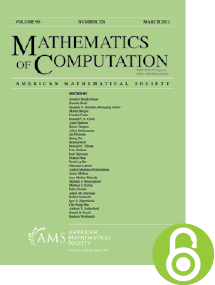A priori and a posteriori analysis of the quasinonlocal quasicontinuum method in 1D
HTML articles powered by AMS MathViewer
- by Christoph Ortner PDF
- Math. Comp. 80 (2011), 1265-1285 Request permission
Abstract:
For a next-nearest neighbour pair interaction model in a periodic domain, a priori and a posteriori analyses of the quasinonlocal quasicontinuum method (QNL-QC) are presented. The results are valid for large deformations and essentially guarantee a one-to-one correspondence between atomistic solutions and QNL-QC solutions. The analysis is based on consistency error estimates in negative norms, novel a priori and a posteriori stability estimates, and a quantitative inverse function theorem.References
- Marcel Arndt and Mitchell Luskin, Error estimation and atomistic-continuum adaptivity for the quasicontinuum approximation of a Frenkel-Kontorova model, Multiscale Model. Simul. 7 (2008), no. 1, 147–170. MR 2399541, DOI 10.1137/070688559
- Marcel Arndt and Mitchell Luskin, Goal-oriented adaptive mesh refinement for the quasicontinuum approximation of a Frenkel-Kontorova model, Comput. Methods Appl. Mech. Engrg. 197 (2008), no. 49-50, 4298–4306. MR 2463663, DOI 10.1016/j.cma.2008.05.005
- Xavier Blanc, Claude Le Bris, and Frédéric Legoll, Analysis of a prototypical multiscale method coupling atomistic and continuum mechanics, M2AN Math. Model. Numer. Anal. 39 (2005), no. 4, 797–826. MR 2165680, DOI 10.1051/m2an:2005035
- Matthew Dobson and Mitchell Luskin, Analysis of a force-based quasicontinuum approximation, M2AN Math. Model. Numer. Anal. 42 (2008), no. 1, 113–139. MR 2387424, DOI 10.1051/m2an:2007058
- Matthew Dobson and Mitchell Luskin, An optimal order error analysis of the one-dimensional quasicontinuum approximation, SIAM J. Numer. Anal. 47 (2009), no. 4, 2455–2475. MR 2525607, DOI 10.1137/08073723X
- M. Dobson, M. Luskin, and C. Ortner, Accuracy of quasicontinuum approximations near instabilities, J. Mech. Phys. Solids 58 (2010), 1741–1757.
- —, Iterative methods for the force-based quasicontinuum approximation, Comput. Mathods Appl. Mech. Engrg., doi: 10.1016/j.cma.2010.07.008, 2010.
- —, Sharp stability estimates for the force-based quasicontinuum approximation of homogeneous tensile deformation, Multiscale Model. Simul. 8 (2010), no. 3, 782–802.
- —, Stability, instability, and error of the force-based quasicontinuum approximation, Arch. Ration. Mech. Anal. 197 (2010), no. 1, 179.
- W. E, J. Lu, and J.Z. Yang, Uniform accuracy of the quasicontinuum method, Phys. Rev. B 74 (2004), no. 21, 214115.
- Wei-nan E and Ping-bing Ming, Cauchy-Born rule and the stability of crystalline solids: dynamic problems, Acta Math. Appl. Sin. Engl. Ser. 23 (2007), no. 4, 529–550. MR 2329067, DOI 10.1007/s10255-007-0393
- Weinan E and Pingbing Ming, Cauchy-Born rule and the stability of crystalline solids: static problems, Arch. Ration. Mech. Anal. 183 (2007), no. 2, 241–297. MR 2278407, DOI 10.1007/s00205-006-0031-7
- X.H. Li and M. Luskin, A generalized quasi-nonlocal atomistic-to-continuum coupling method with finite range interaction, arXiv:1007.2336v1
- Ping Lin, Convergence analysis of a quasi-continuum approximation for a two-dimensional material without defects, SIAM J. Numer. Anal. 45 (2007), no. 1, 313–332. MR 2285857, DOI 10.1137/050636772
- Mitchell Luskin and Christoph Ortner, An analysis of node-based cluster summation rules in the quasicontinuum method, SIAM J. Numer. Anal. 47 (2009), no. 4, 3070–3086. MR 2551158, DOI 10.1137/080743391
- R.E. Miller and E.B. Tadmor, Benchmarking multiscale methods, Modelling and Simulation in Materials Science and Engineering 17 (2009), p. 053001.
- —, The Quasicontinuum Method: Overview, Applications and Current Directions, Journal of Computer-Aided Materials Design 9 (2003), 203–239.
- Pingbing Ming and Jerry Zhijian Yang, Analysis of a one-dimensional nonlocal quasi-continuum method, Multiscale Model. Simul. 7 (2009), no. 4, 1838–1875. MR 2539201, DOI 10.1137/080725842
- M. Ortiz, R. Phillips, and E.B. Tadmor, Quasicontinuum Analysis of Defects in Solids, Philosophical Magazine A 73 (1996), no. 6, 1529–1563.
- C. Ortner, A posteriori existence in numerical computations, SIAM J. Numer. Anal. 47 (2009), no. 4, 2550–2577. MR 2525611, DOI 10.1137/060668183
- Christoph Ortner and Endre Süli, Analysis of a quasicontinuum method in one dimension, M2AN Math. Model. Numer. Anal. 42 (2008), no. 1, 57–91. MR 2387422, DOI 10.1051/m2an:2007057
- C. Ortner and H. Wang, A priori error analysis for energy-based quasicontinuum approximations of a periodic chain, OxMOS preprint no. 30/2010, Mathematical Institute, University of Oxford.
- Michael Plum, Computer-assisted enclosure methods for elliptic differential equations, Linear Algebra Appl. 324 (2001), no. 1-3, 147–187. Special issue on linear algebra in self-validating methods. MR 1810529, DOI 10.1016/S0024-3795(00)00273-1
- S. Prudhomme, P.T. Bauman, and J.T. Oden, Error control for molecular statics problems, International Journal for Multiscale Computational Engineering 4 (2006), no. 5-6, 647–662.
- A. Shapeev, Consistent energy-based atomistic/continuum coupling for two-body potential: 1d and 2d case, arXiv:1010.0512
- V. B. Shenoy, R. Miller, E. B. Tadmor, D. Rodney, R. Phillips, and M. Ortiz, An adaptive finite element approach to atomic-scale mechanics—the quasicontinuum method, J. Mech. Phys. Solids 47 (1999), no. 3, 611–642. MR 1675219, DOI 10.1016/S0022-5096(98)00051-9
- T. Shimokawa, J.J. Mortensen, J. Schiotz, and K.W. Jacobsen, Matching conditions in the quasicontinuum method: Removal of the error introduced at the interface between the coarse-grained and fully atomistic region, Phys. Rev. B 69 (2004), no. 21, 214104.
Additional Information
- Christoph Ortner
- Affiliation: Mathematical Institute, 24-29 St Giles’, Oxford OX1 3LB, United Kingdom
- MR Author ID: 803698
- Email: ortner@maths.ox.ac.uk
- Received by editor(s): November 7, 2009
- Received by editor(s) in revised form: May 15, 2010
- Published electronically: December 31, 2010
- Additional Notes: This work was supported by the EPSRC Critical Mass Programme “New Frontiers in the Mathematics of Solids”.
- © Copyright 2010
American Mathematical Society
The copyright for this article reverts to public domain 28 years after publication. - Journal: Math. Comp. 80 (2011), 1265-1285
- MSC (2010): Primary 65N12, 65N15, 70C20
- DOI: https://doi.org/10.1090/S0025-5718-2010-02453-6
- MathSciNet review: 2785458


